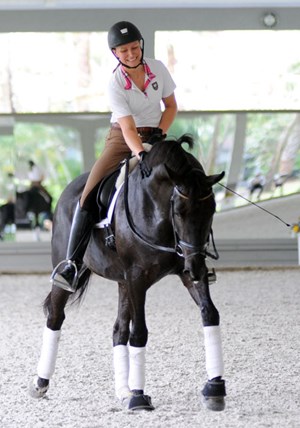When riding, we often are aware of when a mistake happens, but it can be harder to identity WHY the mistake happens. Identifying the difference between the symptom and the cause of an issue can be difficult, but it is an important skill for becoming a competent rider and trainer.

Animals are trained through positive and negative reinforcement. Positive reinforcement is the addition of a positive stimulus after a desired behavior has been exhibited. Examples are a pat on the neck, a walk break, or a sugar cube treat.
Negative reinforcement can be more complicated to understand. As anyone with a psychology background knows, negative reinforcement does NOT mean being mean to the animal, and it is NOT the same as punishment.
Negative reinforcement is the removal of a certain stimulus (usually an aversive stimulus) after a desired behavior is exhibited. For example, a rider pulls on the reins to slow a horse down. Once the horse slows down, the rider stops pulling on the reins. The stimulus of the rein pressure has been removed, and therefore the horse knows it answered correctly by slowing down.
Understanding the power of negative reinforcement is important for us as riders. A common issue I see people having in canter work is that the horse pops its outside shoulder out and travels with its haunches falling to the inside. To correct this crookedness, I have people ride a shoulder-in in the canter.
To ride the shoulder-in, the rider asks the horse to move its haunches away from their inside leg, while resisting with the outside rein to bring the shoulders slightly off the track. When they first ask for the shoulder-in, a lot of horses will make the mistake of swapping leads or throwing in a flying change, as an evasion from willingly moving away from the inside leg.
Most people’s first reaction when this mistake happens is to pull on the inside rein, or ask for a flying change back to the correct lead, or to walk and pick up the correct lead again. But it is important to realize that the lead swapping was just the SYMPTOM of the issue.
The CAUSE of the issue was that the horse didn’t want to move its haunches away from the rider’s inside leg. By allowing the horse to walk or by asking for a flying change back to the correct lead, the rider has then momentarily removed the pressure of their inside leg. Therefore, since the inside leg pressure goes away, the horse thinks it must have done the correct response by swapping leads. So the rider will continue to struggle with the shoulder-in because every time the horse swaps leads, the rider’s inside leg pressure goes away and therefore the horse thinks it gave the correct response. Unknowingly the rider is reinforcing the lead swapping.
To stop this cycle, I tell riders to focus only on the reaction from their inside leg. Whether the horse swaps leads, breaks to trot, or even if they have to come to walk to accomplish it, it doesn’t matter. They should continue to keep their inside leg on until the horse steps its haunches away from it. Even if the horse throws in a flying change and is now counter-cantering, if the rider stays persistent about making the horse move off their inside leg, then the horse realizes the leg pressure goes away when he moves his haunches to the outside, not when he swaps leads.
A lot of confusion for the horse can be eliminated when the rider is able to break things down and figure out what is the symptom, as opposed to the real cause of an issue. The rider has to stay focused and not remove the aid at the wrong moment, otherwise he or she is inadvertently reinforcing the wrong response. Half the battle is understanding the horse’s psychology and making sure we are speaking in a language it can understand. This is part of what makes dressage so challenging and fascinating to me.











